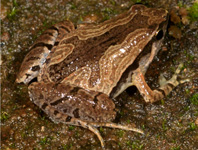Abstract
Gothograptus? meganassa Rickards & Palmer, 2002 is assigned to a new genus Semigothograptus. New, well preserved material from the dubius/nassa Biozone (upper Homerian, Silurian) of the Bartoszyce IG-1 drill core Poland is described. This provides a new phylogenetic perspective on the evolution of post-lundgreni Event retiolitines. Semigothograptus meganassa is considered to be a descendant of Gothograptus nassa, although one of the most significant differences between these forms is the position of the nema, and narrow finite tubarium ending in an appendix in G. nassa. S. meganassa possesses looping meshes of the ancora umbrella recognised in Gothograptus, Papiliograptus, and Baculograptus and shares the common characters of all stratigraphical younger retiolitines. It is recognised that the S. meganassa is known from four terrains: Avalonia, Baltica, Bohemia, and Saxo-Thuringia. Analysis of the genicular hoods of nassa type, characteristic of Gothograptus nassa, Gothograptus kozlowskii, Semigothograptus meganassa, and Neogothograptus eximinassa, demonstrates their unique, solid bandage construction.
References
Bates, D.E.B. (1990) Retiolite nomenclature and relationships. Journal of the Geological Society, 147, 717–723.
https://doi.org/10.1144/gsjgs.147.4.0717Bates, D.E.B. & Kirk, N.H. (1984) Autecology of Silurian graptoloids. Special Papers in Palaeontology, 32, 121–139.
Bates, D.E.B., Kozłowska, A. & Lenz, A.C. (2005) Silurian retiolitid graptolites: Morphology and evolution. Acta Palaeontologica Polonica, 50, 705–720.
Bouček, B. & Münch, A. (1952) Retioliti středoevropského svrchního wenlocku a ludlowu. Sborník Ústředního ústavu geologického, oddil paleontologický, 19, 1–151.
Calner, M. (2008) Silurian global events – at the tipping point of climate change. In: Elewa, A.M.T. (Ed.), Mass extinctions. Springer-Verlag, Berlin and Heidelberg, pp. 21–58.
https://doi.org/10.1007/978-3-540-75916-4_4Frech, F. (1897) Lethaea geognostica, 1 Lethaea palaeozoica, II. Graptolithiden, Stuttgart, 544–684.
Gutiérres-Marco, J.C., Lenz, A.C., Robardet, M. & Piçarra, J.M. (1996) Wenlock-Ludlow graptolite biostratigraphy and extinction: A reassessment from the southwestern Iberian Peninsula (Spain and Portugal). Canadian Journal of Earth Sciences, 33, 656–63.
https://doi.org/10.1139/e96-049Holm, G. (1890) Gotlands graptoliter. Svenska Vetenskap-Akademiens handlingar, 16, 1–34.
Jaeger, H., (1991) Neue Standard-Graptolithenzonenfolge nach der “Grossen Krise” und der Wenlock/Ludlow-Grenze (Silur). Neues Jahrbuch für Geologie und Paläontologie - Abhandlungen, 182, 303–354. [in German with English abstract]
Jeppsson, L. & Calner, M. (2003) The Silurian Mulde event and a scenario for secundo–secundo events. Transaction of the Royal Society Edinburgh of Earth Sciences, 93, 135–154.
https://doi.org/10.1017/S0263593300000377Koren’, T.N. (1991) The C. lundgreni extinction event in Central Asia and its bearing on graptolite biochronology within the Homerian. Proceedings of Estonian Academy of Sciences, Geology, 40, 74–78.
Kozłowska, A. (2015) Evolutionary history of the Gothograptus lineage of the Retiolitidae (Graptolithina). Estonian Journal of Earth Sciences, 64, 56–61.
https://doi.org/10.3176/earth.2015.10Kozłowska, A. & Radzevičius, S. (2013) Upper Homerian and Gorstian (Silurian) Retiolitidae (Graptolithina) from Lithuania and Latvia. Memoirs of the Association of Australasian Palaeontologists, 44, 11–23.
Kozłowska A., Lenz, A.C. & Melchin, M. (2009) Evolution of the retiolitid Neogothograptus (Graptolithina) and its new species from the upper Wenlock of Poland, Baltica. Acta Palaeontologica Polonica, 54, 423–434.
https://doi.org/10.4202/app.2008.0022Kozłowska-Dawidziuk , A. (1990) The genus Gothograptus (Graptolithina) from the Wenlock of Poland. Acta Palaeontologica Polonica, 35, 191–209.
Kozłowska-Dawidziuk, A. (1995) Silurian retiolitids of the East European Platform. Acta Palaeontologica Polonica, 40, 261–326.
Kozłowska-Dawidziuk, A. (1997) Retiolitid graptolite Spinograptus from Poland and its membrane structures. Acta Palaeontologica Polonica, 42, 391–412.
Kozłowska-Dawidziuk , A. (2001) Phylogenetic relationships within the Retiolitidae (Graptolithina) and a new genus, Cometograptus. Lethaia, 34, 84–96.
https://doi.org/10.1080/002411601300068314Kozłowska-Dawidziuk, A. (2004) Evolution of retiolitid graptolites - a synopsis. Acta Palaeontologica Polonica, 49, 505–518.
Kozłowska-Dawidziuk, A., Lenz, A.C. & Štorch, P. (2001) Upper Wenlock and lower Ludlow (Silurian), post-extinction graptolites, Všeradice section, Barrandian area, Czech Republic. Journal of Paleontology, 75, 147–164.
https://doi.org/10.1666/0022-3360(2001)075%3C0147:UWALLS%3E2.0.CO;2Lapworth, C. (1873) Notes on the British graptolites and their allies. 1. On an improved classification of the Rhabdophora. Geological Magazine, 10, 500–504, 555–560.
https://doi.org/10.1017/s0016756800469372Lenz, A.C. (1993) Late Wenlock and Ludlow (Silurian) Plectograptinae (retiolitid graptolites), Cape Phillips Formation, Arctic Canada. Bulletins of American Paleontology, 104, 1–52.
Lenz, A.C. (1994a) Uppermost Wenlock and lower Ludlow plectograptine graptolites, Arctic Islands, Canada: new isolated material. Journal of Paleontology, 68, 851–860.
https://doi.org/10.1017/S0022336000026305Lenz, A.C. (1994b) A sclerotized retiolitid, and its bearing on origin and evolution of Silurian retiolitid graptolites. Journal of Paleontology, 68, 1344–1349.
https://doi.org/10.1017/S0022336000034326Lenz, A.C. & Kozłowska, A. (2006) Graptolites from the lundgreni Biozone (Lower Homerian, Silurian), Arctic Islands, Canada: new species and supplementary material. Journal of Paleontology, 80, 616–637.
https://doi.org/10.1666/0022-3360(2006)80[616:GFTLBL]2.0.CO;2Lenz, A.C. & Kozłowska-Dawidziuk, A. (2002) Upper Homerian (Upper Wenlock, Silurian) graptolites from Arctic Canada. Journal of Paleontology, 76, 321–346.
https://doi.org/10.1017/S0022336000041731Lenz, A.C. & Melchin, M.J. (1987) Silurian retiolitids from the Cape Phillips Formation, Arctic Canada. Bulletin of the Geological Society of Denmark, 35, 161–170.
Maletz, J. (2008) Retiolitid graptolites from the collection of Hermann Jaeger in the Museum für Naturkunde, Berlin (Germany). I. Neogothograptus and Holoretiolites. Paläontologische Zeitschrift, 82, 285–307.
https://doi.org/10.1007/BF02988896Maletz, J. (2010) Retiolitid graptolites from the collection of Hermann Jaeger II: Cometograptus, Spinograptus and Plectograptus. Paläontologische Zeitschrift, 84, 501–522.
https://doi.org/10.1007/s12542-010-0065-xMelchin, M.J., Mitchell, C.E., Naczk-Cameron, A., Fan, J.X. & Loxton, J. (2011) Phylogeny and adaptive radiation of the Neograptina (Graptoloida) during the Hirnantian Mass Extinction and Silurian recovery. Proceedings of the Yorkshire Geological Society, 58, 1–30.
https://doi.org/10.1144/pygs.58.4.301Obut, A.M. & Zaslavskaya, N.M. (1976) New data on the early stages of Retiolitidae development. In: Kaljo, D. & Koren’, T.N. (Eds.), Graptolites and Stratigraphy. Academy of Sciences of Estonian SSR, Institute of Geology, Tallinn, pp. 119–127.
Obut, A.M. & Zaslavskaya, N.M. (1983) Families of Retiolitida and their phylogenetical relations [in Russian]. In: Dagys, A.S. & Dubatolov, V.N. (Eds.), Morphology and Systematics of the Phanerozoic Invertebrates. Izdatelstvo Nauka, Moskva, pp. 103–113.
Porębska, E., Kozłowska-Dawidziuk, A. & Masiak, M. (2004) The lundgreni event in the Silurian of the East European Platform, Poland. Palaeogeography, Palaeoclimatology, Palaeoecology, 213, 271–294.
http://dx.doi.org/10.1016/j.palaeo.2004.07.013Rickards, R.B. & Palmer, D.C. (2002) Gothograptus? meganassa sp. nov., an unusually large retiolitid graptoloid from the Late Wenlock ludensis Biozone of Long Mountain, Shropshire, UK. Special Papers in Palaeontology, 67, 225–232.
Suess, E. (1851) Über böhmische Graptolithen. Naturwissenschaftliche Abhandlungen von Haidinger, 4, 87–134.
Štorch, P. (1995) Biotic crises and post-crisis recoveries recorded by Silurian planktonic graptolite faunas of the Barrandian area (Czech Republic). Geolines, 3, 59–70.
Tomczyk, H. (1974) Bartoszyce IG-1, Gołdap IG-1. In: Modliński, Z. (Ed.), Profile głębokich otworów wiertniczych Instytutu Geologicznego, 14, pp. 1–362.

